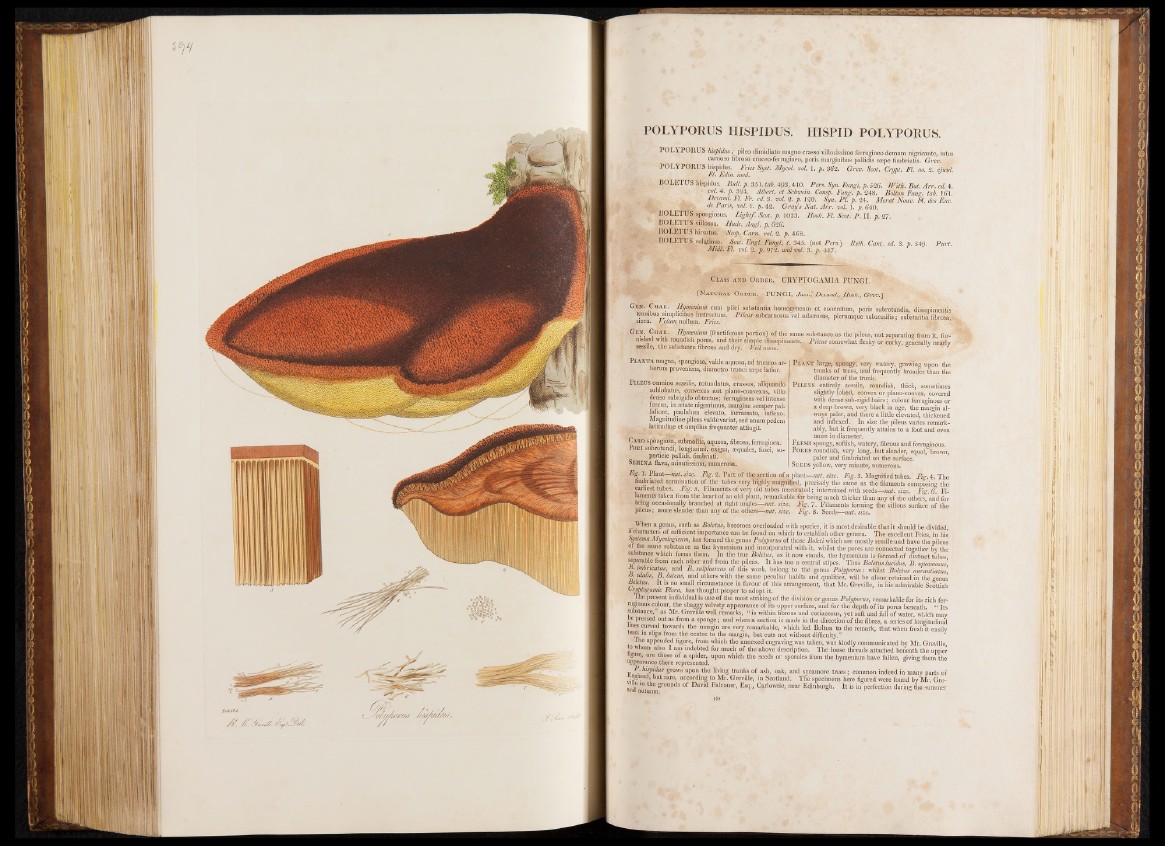
POLYPORUS HISPIDUS. HISPID POLYPORUS.
POLYPORUS hispiäus ; pileo dimidiato magno crasso villosissimo ferrugineo demum nigricante, intus
carnoso fibroso eroceo-ferrugineo, poris marginibus pal lid is saepe fimbriatis. Greo.yy,:
POLYPORUS hispidus. Fries Syst. Mycol. vol. 1. p. 36*2. Greo. Scot. Crypt. FI. no. 2. ejusd.
FI. Edin. ined. c f :
BOLETUS hispidus. Bull. p. 351. tab. 49 3 ,410. Pers. Syn. Fungi, p. 526. With. Bot. Arr. ed. 4.
' i f 4 - ^-324. Albert, et Schwein. Consp. Fung. p. 248. Bolton Fung. tab. 161.
, . Dccand. Fl. Fr. ed. 3. vol. 2. p. 120. Syn. P I p. 24. Merat Nowo. M. des Env.
k . .«* Paris, vol. 1. p. 42. Gray’s Nat. Arr. vol. 1. p. 640.
BOLETUSj|||jngiosus. Lightf. Scot. p. 1033. Hook. FI. Scot. P . II. p. 27.
BOLETUS villosus. Huds. Angl. p , 626.
BOLETUS hirsutus. fScop. Carn. vol. 2. p. 468.
BOLETUS velutinus. ^S’ow. Engl. Fungi, t. 345. (not Pers.) Relh. Cant. ed. 3. p. 549- Purt.
Midi. Fl. vol. 2. p. 972. and vol. 3. p. 447.
Class and Order. CRYPTOGAMIA FUNGI.
[Natural Order. .<FUNGI, Juss., Decand., Hook., Greo.\
Gen. Char. Hymenium cum pilei substantia homogeneum et concretum, poris subrotundis, dissepimentis
tenuibus simplicibus instructuin. Pileus subcarnosus vel suberosus, plerumque subsessilis; substantia fibrosa,;
. sicca. Velum^ nullum. Fries.
Llymenium (fructiferous portion) of the same substance as the pileus, not separating from it, fur-"
' n wJt“ roundish pores, and their simple dissepiments..Pileus somewhat fleshy or corky, generally nearly
sessile, the substance fibrous and dry. Veil none. J ° J J
Planta rnagna, spongiosa, valde aquosa, ad truncos ai-
borum proveniens, diametro tr,unci sajpe latior.
Pileus omnino sessilis, rotundatus, crassus, aliquando
sublobatus, convexus aut plano-convexus, villo
denso subrigido obtectus; ferrugineus vel intense
fuscus, in state nigerrimus, margine semper pal-
lidiore, paululum elevato, incrassato, inflexo.
Magnitudine pileus valde variat, sed unum pedem
^ latitudine et amplius frequenter attingit.
Cauo.spongiosa, submollis, aquosa, fibrosa, ferruginea.
Pori subrotundi/longissinii; exigui, squales, fusci, su-
. perficie pallidi, fimbriati.
Semina flava, minutissima; numerosa.
Fig. 1. Plant—nat. size. Fig. 2. Part of the. section of £
fimbriated termination of the tubes very liighly magn
earliest tubes. Fig. 5 . Filaments of very old tubes m:
laments taken from the heart of an old plant, remarkal
being occasionally branched at right angles— not. size
pileus; more slender than any of the others—nat. size
Plant large* spongy, very watery, growing upon the
trunks of trees, and frequently broader than the
diameter of the trunk.
Pileus entirely sessile, roundish, thick, sometimes
slightly lobed, convex or plano-convex, covered
with dense sub-rigid hairs; colour ferruginous or
a deep brown, very black in age, the margin always
paler, and there a little elevated, thickened
and inflexed. In size the pileus varies remarkably,
but it frequently attains to a foot and even
more in diameter.
F l e s h spongy, softisb, watery, fibrous and ferruginous.
Pores roundish, very long, but slender, equal, brown,
paler and fimbriated on the surface.
Seeds yellow, very minute, numerous.
plant—nat. size. Fig. 3. Magnified tubes. Fig. 4. The
tied, precisely the same as th e filaments composing the
icerated; intermixed with seeds—nat. size. Fig. 6. Fide
for being much thicker than any of the others, and for
• Fig. 7. Filaments forming the villous surface of the
. Fig. 8. Seeds—nat. size.
When a genus, such as Boletus, becomes overloaded with species, it is most desirable that it should be divided
it characters o f sufficient importance can be found on which to establish other genera. The excellent Fries, in his
Systema Mycologicum, has formed the genus Polyporus of those Boleti which are mostly sessile and have the pileus
§ 1 the sa,ne substance as the hymenium and incorporated with it, whilst the pores are connected together by the
substance which forms them. In th e true Boletus, as it now stands, the hymenium is; formed of distinct tubes
separable from each other and from the pileus. It has too a central stipes. Thus Boletus lucidus, B. squamosus,
B. mibricatus, and B. sulphureus of this work, belong to the genus Polyporus: whilst Boletus awrantiacus,
-o. eaulis, B. luteus, and others with the same peculiar habits and qualities, will be alone retained in the genus
Boletus. It is no small circumstance in favour of this arrangement, that Mr. Greville, in his admirable Scottish
^fflptbgamic Flora, has thought proper to adopt it.
The present individual is one of the most striking of the division or genus Polyporus, remarkable for its rich ferruginous
colour, the shaggy velvety appearance of its upper surface, and for the depth o f its pores beneath. “ Its
substance, as Mr. Greville well remarks, “ is within fibrous and coriaceous, yet soft and full of water, which may
.. Passed out as from a sponge; and when a section is made in the direction o f the fibres, a series o f longitudinal
lines curved towards the margin are very remarkable, which led Bolton to the remark, that when fresh it easily
tews m slips from the centre to the margin, but cuts not without difficulty.”
Phe appended figure, from which the annexed engraving was taken, was kindly communicated by Mr. Greville,
to whom also I am indebted for much of the above description. The loose threads attached beneath the upper
gure, -are those of a spider, upon which the seeds or sporules from the hymenium have fallen, giving them the
appearance there represented. 6 5
Fn i‘ a llf iy i §rows upon the living trunks of ash, oak, and sycamore trees; common indeed in many parts of
g and, but rare, according to Mr. Greville, in Scotland. The specimens here figured were found by Mr. Gre-
nn»e ln, e grounc*s of David Falconer, Esq., Carlowrie, near Edinburgh. It is in perfection during th e summer
ana autumn. " 6